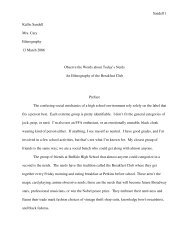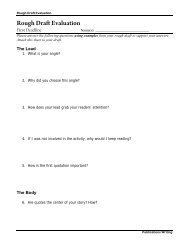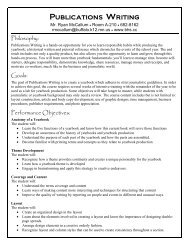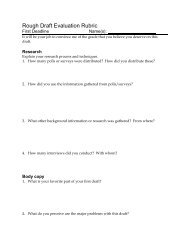Hockey Nights guided reading.pdf - bhs.cc
Hockey Nights guided reading.pdf - bhs.cc
Hockey Nights guided reading.pdf - bhs.cc
- No tags were found...
Create successful ePaper yourself
Turn your PDF publications into a flip-book with our unique Google optimized e-Paper software.
“<strong>Hockey</strong> <strong>Nights</strong>” by Guy LawsonGuided Reading and AnnotationName:Annotate the attached <strong>reading</strong> and answer the following questions. Highlight yourfavorite lines, phrases, words as you read.I. Preface1. How does the description of Flin Flon in the opening (1-2) help to establish someunderstanding of the topic and the culture? How would you summarize the setting?2. What is the author’s connection to the hockey subculture? What do you think hisexpectations are?II. Background Research3. What does this section (5-6) reveal about the importance of this subculture (juniorhockey) to this area? Underline evidence to support your conclusions.III. Observational Data4. Underline examples of artifacts of the subculture (9-10).5. Highlight or underline some of the rituals associated with training camp (11-13).
6. Identify and explain some of the roles of the characters presented in 11-13.7. What is the purpose of the ritual of fighting? What does this ritual reveal about thevalues of the subculture?8. What does the description of the tournament (14-16) reveal about the effect of thissubculture (team) on the larger culture of the town/area? What do the fans value?9. Discuss the rules determined by the coaches (17). What is the underlying purposepresented by these rules? Again, what does this show about the values of the subculture?
10. In 19-20, the author engages in “participant observation” by skating with them atpractice. What does he learn about the players through this experience?What does he learn about himself?11. What roles do you see developed in the dialogue and description in 22-27?12. Underline examples of team rules and rituals (28-29).13. What line indicates that this subculture may be considered “outsiders” in the town,despite their status?14. Comment on how well the author is a<strong>cc</strong>epted by members of the subculture. In whatways does he fit in? In what ways does he remain an outsider?
15. What does the dialogue/conversation among the guys (34-47) reveal about theirindividual and/or group values? Provide some specific examples as support for yourconclusions.16. What do you learn about Meeks (48-54)? How would you describe his role orpersonality? Do you like him? Why or why not?By the way, this is an effective way to present characters in your ethnography. Note theuse of background info/history, transitions, quotes.17. What do you learn about Dodger (55-60)? How would you describe him? Why didthe author choose to highlight him as a character in this piece?18. What is your impression of the Pucks/Bikes? What is their role in this subculture?(Watch your language).
19. Write the conclusion for this piece, based on the information and analysis presented.Consider all of the following:• What did the author learn about his prior assumptions?• What did he learn about himself?• What did he learn about the values of the subculture?• What did he learn about the impact/effects of the larger culture on this subculture?• What did he learn about the impact/effects of this subculture on the larger culture?
















